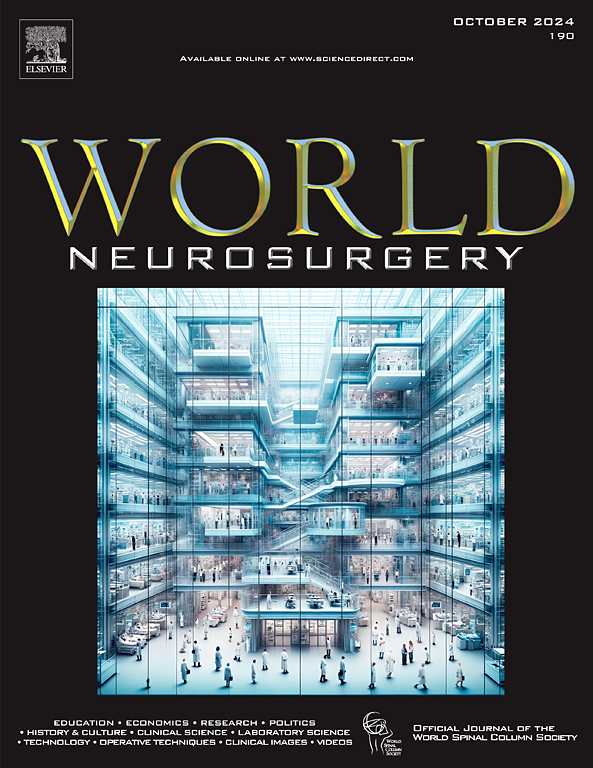Surgical Management and Prognostic Factors for Endolymphatic Sac Tumor: A Single-Institute Experience with a Systematic Review
IF 2.1
4区 医学
Q3 CLINICAL NEUROLOGY
引用次数: 0
Abstract
Objective
To evaluate the clinical features, surgical outcomes, and predictors of progression-free survival (PFS) in patients with endolymphatic sac tumors (ELSTs).
Methods
This retrospective study analyzed 15 cases from Beijing Tiantan Hospital and 237 from the literature (1988–2023), focusing on patients with pathologically confirmed intracranial or skull ELSTs who had comprehensive treatment and follow-up records. Univariate and multivariate Cox regression analyses were used to identify factors influencing PFS.
Results
Patients from our institute comprised 10 males and 5 females, with an average age of 39.1 years. Among these patients, 86.7% underwent gross total resection (GTR). During the follow-up period, 2 patients (13.3%) were lost to follow-up. After a mean follow-up of 74.9 months, 1 patient experienced recurrence and another died from unrelated causes. A review of the literature identified 237 additional patients, including 134 females (56.5%), with an average age of 39.8 years; 22.8% of these patients had von Hippel-Lindau disease. The GTR rate was 69.2%. After a mean follow-up of 53.2 months, 33 recurrences occurred, and the median PFS was 48 months. In addition, 8 patients died during the follow-up period; none of the deaths was attributed to ELSTs. Multivariate analysis identified GTR (hazard ratio, 0.279; 95% confidence interval, 0.086–0.903; P = 0.033) as a significant protective factor against recurrence among the pooled cases.
Conclusions
GTR is crucial for improving PFS in patients with ELST, emphasizing the need for advanced surgical techniques and long-term follow-up because of potential recurrences.
内淋巴囊瘤的手术治疗和预后因素:单个研究所的经验与系统回顾。
目的评估内淋巴囊肿瘤(ELSTs)患者的临床特征、手术效果和无进展生存期(PFS)的预测因素:这项回顾性研究分析了北京天坛医院的15例病例和237篇文献(1988-2023年),重点研究了经病理证实的颅内或颅骨ELST患者,这些患者都有完整的治疗和随访记录。采用单变量和多变量Cox回归分析来确定影响PFS的因素:我院的病例中有 10 名男性和 5 名女性,平均年龄为 39.1 岁。其中,86.7%的患者接受了全切除术(GTR)。在随访期间,有两名患者(13.3%)失去了随访机会。在平均 74.9 个月的随访后,一名患者复发,另一名患者死于无关原因。文献回顾发现,还有237名患者,包括134名女性(56.5%),平均年龄39.8岁;其中22.8%的患者患有冯-希佩尔-林道氏病。GTR率为69.2%。平均随访时间为 53.2 个月,33 例复发,中位生存期为 48 个月。此外,有8名患者在随访期间死亡,其中无一死于ELST。多变量分析发现,GTR(HR 0.279,95% CI 0.086-0.903,p = 0.033)是汇总病例中防止复发的重要保护因素:结论:GTR对改善ELST患者的PFS至关重要,强调了先进手术技术和长期随访的必要性,以防潜在复发。
本文章由计算机程序翻译,如有差异,请以英文原文为准。
求助全文
约1分钟内获得全文
求助全文
来源期刊

World neurosurgery
CLINICAL NEUROLOGY-SURGERY
CiteScore
3.90
自引率
15.00%
发文量
1765
审稿时长
47 days
期刊介绍:
World Neurosurgery has an open access mirror journal World Neurosurgery: X, sharing the same aims and scope, editorial team, submission system and rigorous peer review.
The journal''s mission is to:
-To provide a first-class international forum and a 2-way conduit for dialogue that is relevant to neurosurgeons and providers who care for neurosurgery patients. The categories of the exchanged information include clinical and basic science, as well as global information that provide social, political, educational, economic, cultural or societal insights and knowledge that are of significance and relevance to worldwide neurosurgery patient care.
-To act as a primary intellectual catalyst for the stimulation of creativity, the creation of new knowledge, and the enhancement of quality neurosurgical care worldwide.
-To provide a forum for communication that enriches the lives of all neurosurgeons and their colleagues; and, in so doing, enriches the lives of their patients.
Topics to be addressed in World Neurosurgery include: EDUCATION, ECONOMICS, RESEARCH, POLITICS, HISTORY, CULTURE, CLINICAL SCIENCE, LABORATORY SCIENCE, TECHNOLOGY, OPERATIVE TECHNIQUES, CLINICAL IMAGES, VIDEOS
 求助内容:
求助内容: 应助结果提醒方式:
应助结果提醒方式:


